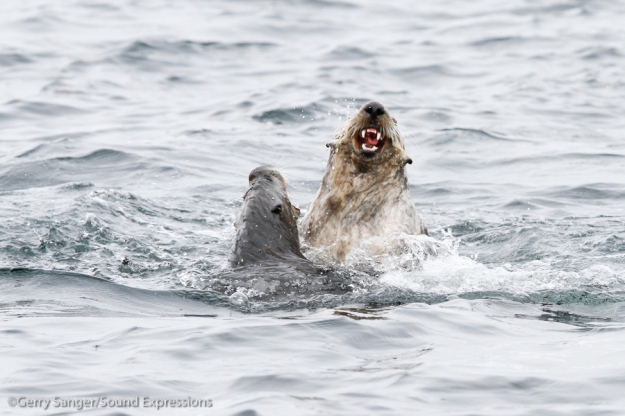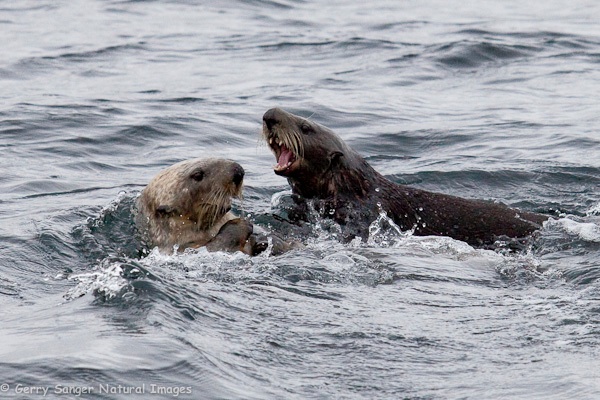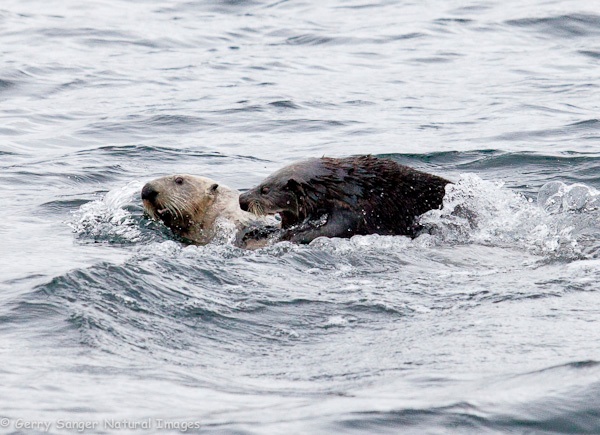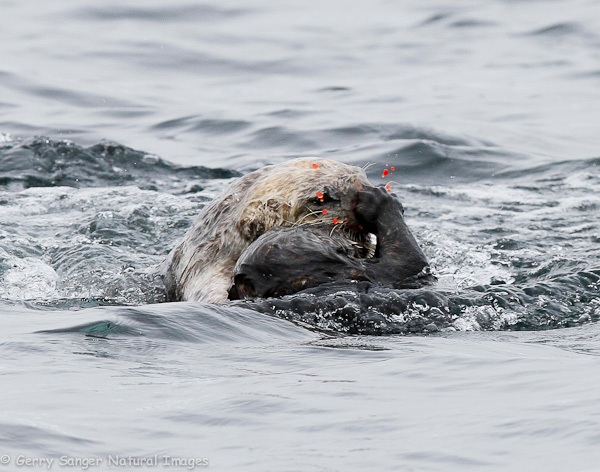First published in the online version of Alaska Magazine in 2013 at: http://www.alaskamagazine.com/10-articles/221-rough-lovin-sea-otters
Upon watching sea otters for any length of time, one easily gets the impression that they are the epitome of sociability. They float on their backs in amicable groups, often close to each other. Mother otters carry their babies, and even older young ones on their bellies. This is the scene encountered again and again by folks who spend much time on the water in Prince William Sound.
A few years ago, however, while aboard my boat in the southwestern Sound, two companions and I witnessed a far different side of sea otters. We came upon two otters that were splashing around in the water in what first seemed to be play. As we continued watching them, it was soon evident that they weren’t playing at all — they were fighting. A larger, blond-headed otter was chasing a smaller, darker one, who was resisting stoutly.



I had been watching sea otters on the Sound for over 30 years, and this was the first time I had seen them behaving other than peacefully. What was going on? How could such normally peaceful critters be other than the cute, cuddly ones that they seemed to be?

No way Jose’ — get AWAY from me!
The three of us were well equipped with camera gear, and we shot as much of the action as we could. After eight minutes of aggressive tussling, the determined female ended the fight by raking her stoutly-clawed paw across the male’s nose, sending drops of blood flying. The much larger male finally left the smaller female in peace, and they swam away in opposite directions.

As we continued on our way, we were puzzled by what we had just seen. The otters had been thrashing about, often under water, or hidden by clouds of spray when on the surface. At home on my computer, after studying the many images I had taken, and discussing the event with a sea otter biologist, a clearer picture of what had happened began to emerge. The larger, blond-headed otter was a male, who was trying to force his romantic intentions on a smaller, darker female, but the female wasn’t interested.
Once before I had come upon a pair of sea otters mating peacefully at the surface of the water in a quiet back-channel of the Sound, but that scene had mirrored my prior perception of sea otters as totally peaceful creatures. As the male held the female from behind with his paws, the pair alternately copulated vigorously for several seconds, mostly under water, then paused briefly with their heads above water — presumably to breathe — and then resumed the action. This went on for several minutes as the pairs’ motions carried them away from our drifting boat, and they were still at it when we quietly motored away.
When Olaus Murie visited the Aleutians in the mid-1930’s he got a brief glimpse of sea otter mating behavior, and wrote, “It took place in the water, as the pair rolled over and over, sometimes being at the surface, sometimes underneath, the male grasping the female by the head, with his teeth.” That sounded similar to what the three of us had seen, but it took further digging into the scientific record to get more details. Twenty years after Murie was in the Aleutians, marine biologist Karl Kenyon was in the Aleutians from 1955 to 1965, studying sea otters for the US Fish and Wildlife Service. He was able to paint a more complete description of sea otter mating behavior in his resulting 1969 classic of Alaskan wildlife literature, “The Sea Otter in the Eastern Pacific Ocean.” For 352 pages, Kenyon described in dizzying detail every aspect of sea otter natural history, including their courtship and breeding behavior. He filled in the blanks of what Murie’s one, brief observation had just hinted at. Sea otter courtship and mating is aggressive, taking place near and on a haulout rock of the female’s choosing. Males establish mating territories and exclude other males, but it is only when the female is in season that she allows the male’s advances to escalate into mating.
When the female is receptive, the male may grasp her about the chest from behind with his front paws and try to grab the side or her head or her nose with his teeth. At this rather rough stage of courtship, the female may break away, snap at the male, and push him away with her flippers and paws. The two may now separate, but if the female is not determined in her resistance the male may follow her. Occasionally, a female will follow the male and rough courtship continues. If the female is in heat, she becomes increasingly submissive, and the male usually grabs the female’s upper jaw or side of her head in his jaws, including her nose. In one case, after copulation had continued for 14 minutes, the female struggled free of the male. However, the male held his grip on the female’s head with his jaws, and the two animals spun rapidly over and over on the surface. After a few seconds of spinning, the female again relaxed, the male grasped her from behind with his paws, and copulation continued for an additional 9.5 minutes. When the male finally released his grip after those twenty-three and a half minutes, the female’s nose was gashed and bleeding. The two animals immediately began to groom and scrub their fur. With the female leading, the pair then swam to and hauled out on the rock where they had previously engaged in courtship. They continued grooming and drying their fur for 10 minutes, after which the pair went to sleep curled up close beside each other on the rock.
While most observations showed that the male initiated mating, Kenyon sometimes saw an estrous female teasing a reluctant male. One time, he saw a male and female sleeping close beside each other in a kelp patch. They appeared to be a mated pair, and he presumed that they had previously copulated. The female awoke and began nuzzling the male about the head and abdomen. The male slowly awakened, and at first was indifferent. Within half a minute, however, he grabbed her with his forepaws, held the side of her head in his jaws, the female became rigid, and copulation ensued. After 11 minutes, they were still connected, but their motions carried them behind rocks, out of Kenyon’s view. Other biologists report that copulation usually continues for at least 15 to 20 minutes, and sometimes as long as 30 minutes or more. Kenyon never saw the results of unsuccessful courtship attempts by males toward unreceptive females. If a female was unreceptive, she rolled away from him, pushing him with her flippers and paws, or she snapped at him. Kenyon said nothing about males persisting in their attempts in spite of a female’s continued resistance, as my companions and I had seen.
What we had been privileged to witness was unusual because the male continued pursuing the female in spite of her aggressive rejection. Her persistent resistance — to the point of drawing blood from the male more than once — is what finally drove him away.
End Story


Fantastic writing, I sure enjoyed your experience. Thank you for sharing. Ursula
LikeLiked by 1 person
Thanks, Ursi. More coming!
LikeLike
WOW….another incredible memory shared by Gerry….thank you so much for sharing.. Ken and Denise Zirkle
LikeLiked by 1 person